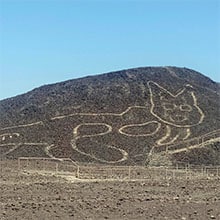 The dictionary of the Royal Spanish Academy ( RAE ) does not include the term geoglyph . However, according to the Urgent Spanish Foundation ( Fundéu BBVA ), it is a specialized concept whose use is appropriate even though general dictionaries do not contemplate it.
The dictionary of the Royal Spanish Academy ( RAE ) does not include the term geoglyph . However, according to the Urgent Spanish Foundation ( Fundéu BBVA ), it is a specialized concept whose use is appropriate even though general dictionaries do not contemplate it.
A figure that is drawn on the ground or on the side of a mountain with earth, stones, etc. is called a geoglyph. Ancient people from various parts of the world used to produce this type of drawings.
There were different techniques for the development of geoglyphs. One method consisted of removing the surface layer of the soil to expose lighter regions, with a lower level of oxidation. Another alternative was based on the use of dark rocks to shape the figures . Also, in some cases, the two procedures were combined.
It is important to mention that geoglyphs, like wall engravings and petroglyphs , are part of rock art. One of the peculiarities of the geoglyphs is their large size, which makes them better appreciated from a considerable distance.
Geoglyphs have been found with an extension of about three meters and others that measure more than one hundred meters. Therefore, their characteristics can be very different.
The most famous geoglyphs are found in Peru . The so-called Nazca lines , located in the current department of Ica , are part of the World Heritage Site that UNESCO has protected since 1994 and include geometric figures, zoomorphic creatures and other designs that would have been created about 2000 years ago.
 It should be noted that the full name of the Nazca lines includes the words "Jumana pampas geoglyphs", but this part is usually omitted to reduce its length. Precisely, it is in these pampas that the geoglyphs are found, in the heart of the Nazca desert and near the town called Palpa. Its designs were created by the Nazca culture, whose development took place between the beginning of the 1st century and the end of the 7th century.
It should be noted that the full name of the Nazca lines includes the words "Jumana pampas geoglyphs", but this part is usually omitted to reduce its length. Precisely, it is in these pampas that the geoglyphs are found, in the heart of the Nazca desert and near the town called Palpa. Its designs were created by the Nazca culture, whose development took place between the beginning of the 1st century and the end of the 7th century.
The number of geoglyphs found in the place is in the hundreds, and their variety, both in shape and complexity, is also worth highlighting. Although this archaeological treasure has been protected by UNESCO since the mid-1990s, the works aimed at creating the Pan-American Highway and the passage of certain automobiles have caused considerable damage to some of the geoglyphs.
As mentioned in a previous paragraph, the measurements of the lines that make up the geoglyphs are very variable. In the particular case of Nazca, some of them are 40 centimeters thick, while others can reach around 2 meters. Regarding the techniques used to cover large areas without making mistakes, such as the involuntary deviation from straight lines, it is believed that their creators used long ropes , a brilliant idea that we continue to use today in all areas of design. , generally with the help of a ruler.
Furthermore, to achieve the translation of the designs on a considerably large scale , the ancient Nazcas probably arranged a series of stakes and strings to generate a large grid, another genius since it is still valid today. It is also necessary to point out that the weather was on its side, since in that region of Peru rainfall is very rare, so it collaborated enormously with the preservation of the works. The average annual temperature is 25 degrees Celsius, making it one of the least humid parts of the world. Additionally, the warm air prevents the wind from erasing the lines.
